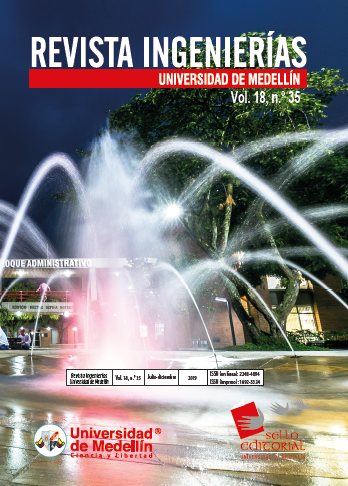Thermal Comfort in Residential Housing in Medellin
Main Article Content
Abstract
The indoor thermal environment of buildings influences people’s health, well-being and productivity, as well as energy consumption. The importance of thermal comfort in buildings has been recognized for decades. However, this aspect is still incipient in the Colombian construction industry, especially in housing projects. In this research, the thermal performance of three common housing types in the city of Medellin was analyzed. To do this, the operative temperature, the predicted mean vote (PMV) and the predicted percentage of dissatisfied (PPD) were calculated in accordance with ISO 7730:2005. The results showed that the thermal inertia of two of the three types of housing examined was insufficient to offer adequate thermal conditions, despite the temperate climate of the Aburra Valley. These results warn about the vulnerability of urban population in Colombia to extreme temperature fluctuations.
Article Details
References
[1] Thermal Environmental Conditions for Human Occupancy, ANSI/Ashrae Standard 55-2017, American Society of Heating, Refrigerating and Air-Conditioning Engineers, 2017.
[2] H. M. Vernon y C. G. Warner, 'The influence of the humidity of the air on capacity for work at high temperatures,' Journal of Industrial Hygiene, vol. 32, n.° 3, pp. 431-463, 1932. DOI: https://doi.org/10.1017/S0022172400018167
[3] P. O. Fanger, 'Calculations of thermal comfort: introduction of a basic comfort equation,' Ashrae Transactions, vol. 73, n.° 2, pp. 1-4, 1967.
[4] A. P. Gagge et al., 'An effective t emperature scale based on a simple model of human physiological regulatory response,' Ashrae Transactions, vol. 77, pp. 247-262, 1971.
[5] L. G. Berglund y A. P. Gobelets, 'Subjective human response to low-level air current and asymmetric radiation,' Ashrae Transactions, vol. 93, pp. 497-523, 1987.
[6] Ergonomía del ambiente térmico, Aenor, Asociación Española de Normalización y Certificación, Estándar UNE-EN ISO 7730, 2006.
[7] H. Frederick y J. Rohles, 'Temperature and temperament. A psychologist looks at comfort,' Ashrae Journal, vol. 49, pp. 14-22, 2007.
[8] J. Anderson y M. French, 'Sustainability as promoting well-being: psychological dimensions of thermal comfort,' [En línea], Disponible: https://www.irbnet.de/daten/iconda/CIB20934.pdf, 2010.
[9] K. Fabbri, Indoor thermal comfort perception. A questionnaire approach focusing on children, Switzerland: Springer International Publishing, 147 p., 2015. DOI: https://doi.org/10.1007/978-3-319-18651-1
[10] A. P. Gagge, 'The linearity criterion as applied to partitional calorimetry,' American Journal of Physiology, vol. 116, n.° 3, pp. 656-668, 1936. DOI: https://doi.org/10.1152/ajplegacy.1936.116.3.656.
[11] CCCS, 'Consejo Colombiano de Construcción Sostenible. La vivienda sostenible se abre espacio en el país,' Revista Portafolio, [En línea], Disponible: https://www.cccs.org.co/wp/download/la-vivienda-sostenible-abre-espacio-en-el-pais/?wpdmdl=15044, 2017
[12] Eronomics of the termal environment - Instruments for measuring physical quantities, International Organization for Standarization, , Estándar ISO 7726, 1998.
[13] F. Fernández-García, 'Fundamentos físicos y métodos de evaluación del confort climático en los estudios de bioclimatología humana,' presentado en VI Reunión Nacional de Climatología,Santiago de Compostela, 2000.
[14] Ashrae, 2001 Ashrae Handbook: fundamentals, Atlanta: American Society of Heating,Refrigerating and Air-Conditioning Engineers, 544 p, 2001.
[15] S. Verbeke y A. Audenaert, 'Thermal inertia in buildings: A review of impacts across climate and building use,' Renewable and Sustainable Energy Reviews, vol. 82, n.° 3, pp. 2300-2318, 2018. DOI: https://doi.org/10.1016/j.rser.2017.08.083
[16] K. Ulgen, 'Experimental and theoretical investigation of effects of wall´s thermophysical properties on time lag and decrement factor,' Energy and Buildings, vol. 32, n.° 3, pp. 273-278, 2002. DOI: https://doi.org/10.1016/S0378-7788(01)00087-1
[17] P. Tuohy et al., 'Thermal mass, insulation and ventilation in sustainable housing - an investigation across climate and occupancy,' presentado en IX International IBPSA Conference, Montreal, 2005.
[18] S. Ferrari, 'Building envelope and heat capacity: re-discovering the thermal mass for winter energy saving,' presentado en 2nd Palenc Conference and 28th AIVC Conference on Building Low Energy Cooling and Advanced Ventilation Technologies in the 21st Century, Creta, 2007.
[19] L. Zhu et al., 'Detailed energy saving performance analyses on thermal mass walls demonstrated in a zero energy house,' Energy and Buildings, vol. 41, n.° 3, pp. 303-310, 2009. DOI: https://doi.org/10.1016/j.enbuild.2008.10.003
[20] M. Scott, 'Beating the Heat,' Nasa Earth Observatory, [En línea], Disponible: http://earthobservatory.nasa.gov/Features/GreenRoof/, 2006.
[21] D. Campbell-Lendrum y C. Corvalán, 'Climate change and developing-country cities: implications for environmental health and equity,' Journal of Urban Health, vol. 84, n.° 1, pp. 109-115, 2007. DOI: https://doi.org/10.1007/s11524-007-9170-x





